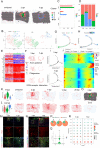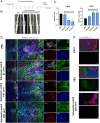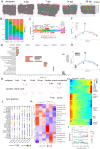Spatiotemporal Dynamics of the Molecular Expression Pattern and Intercellular Interactions in the Glial Scar Response to Spinal Cord Injury
- PMID: 35788904
- PMCID: PMC9905408
- DOI: 10.1007/s12264-022-00897-8
Spatiotemporal Dynamics of the Molecular Expression Pattern and Intercellular Interactions in the Glial Scar Response to Spinal Cord Injury
Abstract
Nerve regeneration in adult mammalian spinal cord is poor because of the lack of intrinsic regeneration of neurons and extrinsic factors - the glial scar is triggered by injury and inhibits or promotes regeneration. Recent technological advances in spatial transcriptomics (ST) provide a unique opportunity to decipher most genes systematically throughout scar formation, which remains poorly understood. Here, we first constructed the tissue-wide gene expression patterns of mouse spinal cords over the course of scar formation using ST after spinal cord injury from 32 samples. Locally, we profiled gene expression gradients from the leading edge to the core of the scar areas to further understand the scar microenvironment, such as neurotransmitter disorders, activation of the pro-inflammatory response, neurotoxic saturated lipids, angiogenesis, obstructed axon extension, and extracellular structure re-organization. In addition, we described 21 cell transcriptional states during scar formation and delineated the origins, functional diversity, and possible trajectories of subpopulations of fibroblasts, glia, and immune cells. Specifically, we found some regulators in special cell types, such as Thbs1 and Col1a2 in macrophages, CD36 and Postn in fibroblasts, Plxnb2 and Nxpe3 in microglia, Clu in astrocytes, and CD74 in oligodendrocytes. Furthermore, salvianolic acid B, a blood-brain barrier permeation and CD36 inhibitor, was administered after surgery and found to remedy fibrosis. Subsequently, we described the extent of the scar boundary and profiled the bidirectional ligand-receptor interactions at the neighboring cluster boundary, contributing to maintain scar architecture during gliosis and fibrosis, and found that GPR37L1_PSAP, and GPR37_PSAP were the most significant gene-pairs among microglia, fibroblasts, and astrocytes. Last, we quantified the fraction of scar-resident cells and proposed four possible phases of scar formation: macrophage infiltration, proliferation and differentiation of scar-resident cells, scar emergence, and scar stationary. Together, these profiles delineated the spatial heterogeneity of the scar, confirmed the previous concepts about scar architecture, provided some new clues for scar formation, and served as a valuable resource for the treatment of central nervous system injury.
Keywords: Glial scar; Microenvironment; Salvianolic acid; Spatial transcriptomics; Spinal cord injury; Therapeutic strategy.
© 2022. The Author(s).
Conflict of interest statement
The authors declare that they have no conflict of interests.
Figures










Similar articles
-
SU16f inhibits fibrotic scar formation and facilitates axon regeneration and locomotor function recovery after spinal cord injury by blocking the PDGFRβ pathway.J Neuroinflammation. 2022 Apr 16;19(1):95. doi: 10.1186/s12974-022-02449-3. J Neuroinflammation. 2022. PMID: 35429978 Free PMC article.
-
The Role of Inflammatory Cascade and Reactive Astrogliosis in Glial Scar Formation Post-spinal Cord Injury.Cell Mol Neurobiol. 2024 Nov 23;44(1):78. doi: 10.1007/s10571-024-01519-9. Cell Mol Neurobiol. 2024. PMID: 39579235 Free PMC article. Review.
-
Glial scar survives until the chronic phase by recruiting scar-forming astrocytes after spinal cord injury.Exp Neurol. 2023 Jan;359:114264. doi: 10.1016/j.expneurol.2022.114264. Epub 2022 Nov 3. Exp Neurol. 2023. PMID: 36336030
-
EphA4 deficient mice maintain astroglial-fibrotic scar formation after spinal cord injury.Exp Neurol. 2010 Jun;223(2):582-98. doi: 10.1016/j.expneurol.2010.02.005. Epub 2010 Feb 17. Exp Neurol. 2010. PMID: 20170651 Free PMC article.
-
Current Advancements in Spinal Cord Injury Research-Glial Scar Formation and Neural Regeneration.Cells. 2023 Mar 9;12(6):853. doi: 10.3390/cells12060853. Cells. 2023. PMID: 36980193 Free PMC article. Review.
Cited by
-
Enhanced axon outgrowth of spinal motor neurons in co-culturing with dorsal root ganglions antagonizes the growth inhibitory environment.Regen Ther. 2023 Dec 10;25:68-76. doi: 10.1016/j.reth.2023.11.013. eCollection 2024 Mar. Regen Ther. 2023. PMID: 38148872 Free PMC article.
-
Spatial transcriptomics in development and disease.Mol Biomed. 2023 Oct 9;4(1):32. doi: 10.1186/s43556-023-00144-0. Mol Biomed. 2023. PMID: 37806992 Free PMC article. Review.
-
The role of foam cells in spinal cord injury: challenges and opportunities for intervention.Front Immunol. 2024 Mar 13;15:1368203. doi: 10.3389/fimmu.2024.1368203. eCollection 2024. Front Immunol. 2024. PMID: 38545108 Free PMC article. Review.
-
Nanomaterials as therapeutic agents to modulate astrocyte-mediated inflammation in spinal cord injury.Mater Today Bio. 2023 Nov 29;23:100888. doi: 10.1016/j.mtbio.2023.100888. eCollection 2023 Dec. Mater Today Bio. 2023. PMID: 38075250 Free PMC article. Review.
-
Salvianolic Acid B: A Review of Pharmacological Effects, Safety, Combination Therapy, New Dosage Forms, and Novel Drug Delivery Routes.Pharmaceutics. 2023 Aug 29;15(9):2235. doi: 10.3390/pharmaceutics15092235. Pharmaceutics. 2023. PMID: 37765204 Free PMC article. Review.
References
-
- Courtine G, Sofroniew MV. Spinal cord repair: Advances in biology and technology. Nat Med. 2019;25:898–908. - PubMed
MeSH terms
Substances
LinkOut - more resources
Full Text Sources
Medical
Research Materials
Miscellaneous

